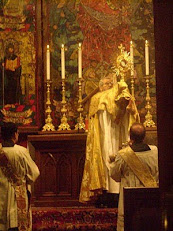Jason Catania tells the story of a parish going home
The story of the decision by Mount Calvary Church, Baltimore to accept the Holy Father’s generous offer in Anglicanorum Coetibus is not yet at an end. Nonetheless, I am pleased to have this opportunity to relate how we have reached this historic moment.
The story begins not with the publication of the apostolic constitution itself, nor with any of the various departures from historic Catholic belief and practice by the Episcopal Church, though these are indeed significant aspects in the tale. Rather, the story begins early in the parish’s 170-year history.
Founded under Tractarian principles in 1842, Mount Calvary soon became known as a center of advanced Anglo- Catholicism. In his discussion of the anti-ritualist 1871 General Convention in his book The Catholic Movement in the Episcopal Church, Canon George E. DeMille writes: "For a decade, Mount Calvary Church, Baltimore, had been a center of Catholic teaching and of ritualistic practice..."
From High Church to Anglo-Catholic
Indeed, under the rectorship of Father Alfred Curtis, Mount Calvary made the transition from High Church to full-blown Anglo-Catholicism (including the first daily Mass in the Episcopal Church in 1868) and it was likely during his time at Mount Calvary that confessional boxes were installed in the church...
Read the rest at Anglican Patrimony.
Hat tip to The Cavalier's Commonplace Book.
Obituary of a very failed Pontificate
-
"Nun khre methusthen kai tina per bian ponen, epei de katthane
Mursilos."Such would have been the reaction of the unchristianised Greeks.
But for us, for t...
2 months ago














No comments:
Post a Comment